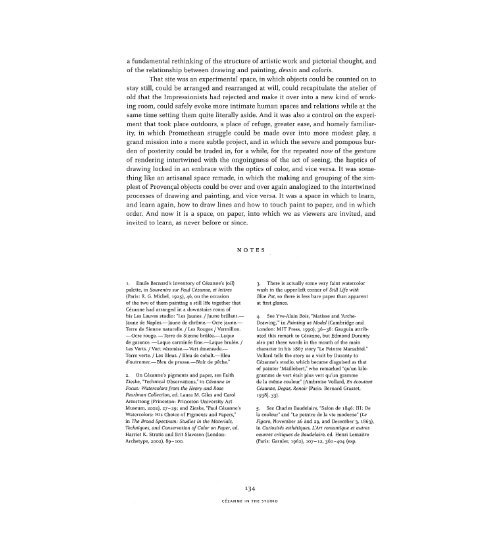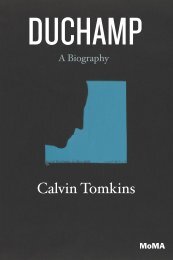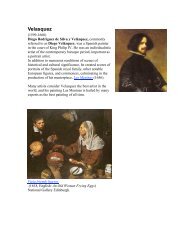Still Life in Watercolors
qbj8dgc
qbj8dgc
- No tags were found...
You also want an ePaper? Increase the reach of your titles
YUMPU automatically turns print PDFs into web optimized ePapers that Google loves.
a fundamental reth<strong>in</strong>k<strong>in</strong>g of the structure of artistic work and pictorial thought, and<br />
of the relationship between draw<strong>in</strong>g and pa<strong>in</strong>t<strong>in</strong>g, dess<strong>in</strong> and colons.<br />
That site was an experimental space, <strong>in</strong> which objects could be counted on to<br />
stay still, could be arranged and rearranged at will, could recapitulate the atelier of<br />
old that the Impressionists had rejected and make it over <strong>in</strong>to a new k<strong>in</strong>d of work<strong>in</strong>g<br />
room, could safely evoke more <strong>in</strong>timate human spaces and relations while at the<br />
same time sett<strong>in</strong>g them quite literally aside. And it was also a control on the experiment<br />
that took place outdoors, a place of refuge, greater ease, and homely familiarity,<br />
<strong>in</strong> which Promethean struggle could be made over <strong>in</strong>to more modest play, a<br />
grand mission <strong>in</strong>to a more subtle project, and <strong>in</strong> which the severe and pompous burden<br />
of posterity could be traded <strong>in</strong>, for a while, for the repeated now of the gesture<br />
of render<strong>in</strong>g <strong>in</strong>tertw<strong>in</strong>ed with the ongo<strong>in</strong>gness of the act of see<strong>in</strong>g, the haptics of<br />
draw<strong>in</strong>g locked <strong>in</strong> an embrace with the optics of color, and vice versa. It was someth<strong>in</strong>g<br />
like an artisanal space remade, <strong>in</strong> which the mak<strong>in</strong>g and group<strong>in</strong>g of the simplest<br />
of Provencal objects could be over and over aga<strong>in</strong> analogized to the <strong>in</strong>tertw<strong>in</strong>ed<br />
processes of draw<strong>in</strong>g and pa<strong>in</strong>t<strong>in</strong>g, and vice versa. It was a space <strong>in</strong> which to learn,<br />
and learn aga<strong>in</strong>, how to draw l<strong>in</strong>es and how to touch pa<strong>in</strong>t to paper, and <strong>in</strong> which<br />
order. And now it is a space, on paper, <strong>in</strong>to which we as viewers are <strong>in</strong>vited, and<br />
<strong>in</strong>vited to learn, as never before or s<strong>in</strong>ce.<br />
NOTES<br />
1. Emile Bernard's <strong>in</strong>ventory of Cezanne's (oil)<br />
palette, <strong>in</strong> Souvenirs sur Paul Cezanne, et lettres<br />
(Paris: R. G. Michel, 1925), 46, on the occasion<br />
of the two of them pa<strong>in</strong>t<strong>in</strong>g a still life together that<br />
Cezanne had arranged <strong>in</strong> a downstairs room of<br />
his Les Lauves studio: "Les Jaunes. / Jaime brillant.—<br />
Jaune de Naples.— Jaime de chrome.— Ocre jaune.—<br />
Terre de Sienne naturelle. / Les Rouges / Vermilion.<br />
—Ocre rouge.—Terre de Sienne brulee.—Laque<br />
de garance.—Laque carm<strong>in</strong>ee f<strong>in</strong>e.—Laque brulee. /<br />
Les Verts. / Vert Veronese.—Vert emeraude.—<br />
Terre verte. / Les Bleus. / Bleu de cobalt.— Bleu<br />
d'outremer.—Bleu de prusse.— Noir de peche."<br />
2. On Cezanne's pigments and paper, see Faith<br />
Zieske, "Technical Observations," <strong>in</strong> Cezanne <strong>in</strong><br />
Focus: <strong>Watercolors</strong> from the Henry and Rose<br />
Pearlmari Collection, ed. Laura M. Giles and Carol<br />
Armstrong (Pr<strong>in</strong>ceton: Pr<strong>in</strong>ceton University Art<br />
Museum, 2002), 27-29; and Zieske, "Paul Cezanne's<br />
<strong>Watercolors</strong>: His Choice of Pigments and Papers,"<br />
<strong>in</strong> The Broad Spectrum: Studies <strong>in</strong> the Materials,<br />
Techniques, and Conservation of Color on Paper, ed.<br />
Harriet K. Stratis and Brit Slavesen (London:<br />
Archetype, 2002), 89-100.<br />
3. There is actually some very fa<strong>in</strong>t watercolor<br />
wash <strong>in</strong> the upper-left corner of <strong>Still</strong> <strong>Life</strong> with<br />
Blue Pot, so there is less bare paper than apparent<br />
at first glance.<br />
4. See Yve-Ala<strong>in</strong> Bois, "Matisse and 'Arche-<br />
Draw<strong>in</strong>g,'" <strong>in</strong> Pa<strong>in</strong>t<strong>in</strong>g as Model (Cambridge and<br />
London: MIT Press, 1990), 36-38: Gaugu<strong>in</strong> attributed<br />
this remark to Cezanne, but Edmond Duranty<br />
also put these words <strong>in</strong> the mouth of the ma<strong>in</strong><br />
character <strong>in</strong> his 1867 story "Le Pe<strong>in</strong>tre Marsabiel."<br />
Vollard tells the story as a visit by Duranty to<br />
Cezanne's studio, which became disguised as that<br />
of pa<strong>in</strong>ter "Maillobert," who remarked "qu'un kilogramme<br />
de vert etait plus vert qu'un gramme<br />
de la meme couleur" (Ambroise Vollard, En ecoutant<br />
Cezanne, Degas, Renoir [Paris: Bernard Grasset,<br />
1938], 33)-<br />
5. See Charles Baudelaire, "Salon de 1846: III: De<br />
la couleur" and "Le pe<strong>in</strong>tre de la vie moderne" (Le<br />
Figaro, November 26 and 29, and December 3, 1863),<br />
<strong>in</strong> Curiosites esthetiques, L'Art romantique et autres<br />
oeuvres critiques de Baudelaire, ed. Henri Lemaitre<br />
(Paris: Gamier, 1962), 107-12, 360-404 (esp.<br />
134<br />
CEZANNE IN THE STUDIO




